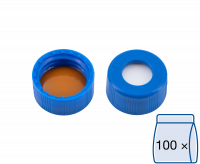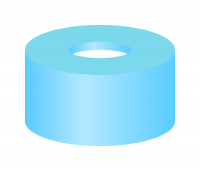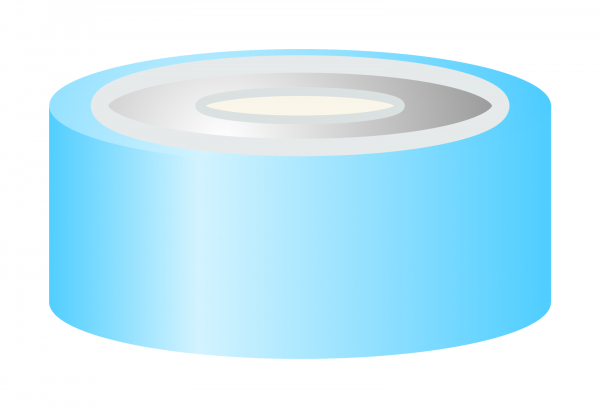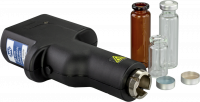Crimp closure, N 20, alu. blue/tin, center hole,Sil. white/Polyimide orange, 3mm
*taxes and shipping not included
Delivery time approx. 5 working days
| Quantity | Price/unit |
|---|---|
| To 9 | $211.00 |
| From 10 | $180.00 |
| From 50 | $162.50 |
Bi-metal crimp closures support transportation of the vial via magnet, as for e.g. in the CTC Combi PAL, the Shimadzu AOC 5000/6000 or the Gerstel autosampler. The septum of this closure is laminated with Polyimide (fluorine-free) instead of PTFE; thus suitable for analysis of fluorinated organic compounds (e.g. PFAS analysis). Septa are assembled, caps are ready-to-use. Septa are shown for illustration purposes only, images upside down.
| Closure type | Crimp closure |
| Nominal diameter | N 20 |
| Assembling process | Assembled |
| Cap material | Aluminum/tin |
| Cap color | Blue/silver |
| Cap hole | Yes |
| Closure magnetic | Yes |
| Septa material | Silicone/Polyimide |
| Colors of septa material | White/orange |
| Septa thickness | 3.0 mm / 118,1 mil |
| Septa hardness | 45° shore A |
| Additional closure features | Fluorine-free |
| Recommended application(s) | Headspace |
| Autosampler compatibility | CTC Combi PAL (Agilent/PerkinElmer/Varian/Thermo Scientific) |
| Storage temperature | 15–25 °C / 59–77 °F |
| Scope of delivery | 100x N 20 ready assembled crimp closures |
| Gross weight (incl. packaging) | 498 g / 1.1 lbs |
| Packaging dimensions | 160 x 160 x 40 mm / 6.30 x 6.30 x 1.57 Inch |
| Hazardous material | No |
PTFE (polytetrafluoroethylene) covers most elastomeric liners in chromatography closures. It is the chemically resistant barrier that on one hand protects the elastomer layer (like silicone or rubber) from being destructed by aggressive solvents/samples and on the other hand the samples from any contaminants possibly emerging out of the carrier material. While it is generally recommendable to have such a chemically resistant barrier between sample and carrier material, the PTFE lamination may become a problem in the analysis of fluorinated compounds, as in e.g. PFAS analysis, as there is the risk that fluorine from the PTFE may migrate into the sample.
A fluorine-free septum, i.e. a septum with a Polyimide instead of a PTFE lamination as the chemically resistant barrier, is therefore recommendable to ensure reliable analysis results.
PTFE-free closures (fluorine-free)

 Crimp closure, N 20, alu., blue/tin,center hole,Sil. blue tr./PTFE colorl.,3.0mm
Crimp closure, N 20, alu., blue/tin,center hole,Sil. blue tr./PTFE colorl.,3.0mm  Crimp closure, N 20, alu.,blue/tin, center hole, Silicone white/PTFE beige,3.0mm
Crimp closure, N 20, alu.,blue/tin, center hole, Silicone white/PTFE beige,3.0mm  Crimp closure, N 20, alu.,blue/tin, center hole,Butyl l. gray/PTFE d. gray,3.0mm
Crimp closure, N 20, alu.,blue/tin, center hole,Butyl l. gray/PTFE d. gray,3.0mm  Screw closure, N 9,PP,blue,c. hole,Sili. w./Polyimide orange,1.0mm,fluorine-free
Screw closure, N 9,PP,blue,c. hole,Sili. w./Polyimide orange,1.0mm,fluorine-free  Snap ring cl., N11,PE(soft), l. blue,hole,Sil w./Polyimide or.,1.0,fluorine-free
Snap ring cl., N11,PE(soft), l. blue,hole,Sil w./Polyimide or.,1.0,fluorine-free  Bi-metal crimp closure, N 20, blue/tin, hole, Sil. blue tr./PTFE(Pharma-Fix),3mm
Bi-metal crimp closure, N 20, blue/tin, hole, Sil. blue tr./PTFE(Pharma-Fix),3mm  Crimp neck vial, N 20, 22.5x75.5 mm, 20.0 mL, rounded bottom, flat neck, clear
Crimp neck vial, N 20, 22.5x75.5 mm, 20.0 mL, rounded bottom, flat neck, clear  Crimp neck vial, N 20, 22.5x46.0 mm, 10.0 mL, rounded bottom, flat neck, clear
Crimp neck vial, N 20, 22.5x46.0 mm, 10.0 mL, rounded bottom, flat neck, clear 









